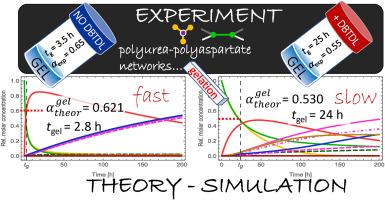基于天冬氨酸的聚脲网络凝胶化的实验和统计模型
IF 4.5
2区 化学
Q2 POLYMER SCIENCE
引用次数: 0
摘要
本研究研究了高性能涂料中天门冬氨酸基聚脲网络的复杂交联机制和动力学,重点研究了一个令人困惑的“凝胶悖论”:我们观察到,添加双酸二丁基锡(DBTDL)显著延长了凝胶时间(7倍),而与直觉相反的是降低了凝胶转化率。这种行为与Flory-Stockmayer理论相矛盾,该理论预测在简单胶凝系统中凝胶转化与反应速率无关。通过FTIR, NMR和MALDI-TOF技术的详细研究,已经阐明了复杂的潜在交联化学。我们发现,除了主要的尿素生成反应外,尿素胺基和天冬氨酸酯之间还发生了连续的氨解反应,导致氢酰脲环的形成,还产生了额外的分支和交联。氨解产生乙醇,乙醇消耗交联剂的异氰酸酯基团,降低其功能。DBTDL的作用是多方面的,不仅可以减缓NCO-NH的主要反应,还可以促进NCO-OH的氨解和促进NCO-OH的反应。一个综合的理论模型结合了这些化学机制,并将其动力学与基于分支过程理论的网络形成的统计模型联系起来,已经得到了发展和验证。该模型准确地预测了凝胶临界转化和时间,有效地解决了凝胶悖论。因此,该模型为理解和控制PU-ASPE网络的形成和结构以获得最佳性能提供了有力的工具。本文章由计算机程序翻译,如有差异,请以英文原文为准。

Experimental and Statistical Modelling of Gelation in Aspartate-Based Polyurea Networks
This research investigates the complex crosslinking mechanism and kinetics of aspartate-based polyurea networks for high-performance coatings, focusing on a puzzling “gelling paradox”: we observed that the addition of dibutyltin dilaurate (DBTDL) dramatically extends the gel time (by 7×), while counterintuitively decreasing the gel conversion. This behaviour contradicts the Flory–Stockmayer theory, which predicts the gel conversion independent of reaction rate in simple gelling systems.Through a detailed investigation employing FTIR, NMR, and MALDI-TOF techniques, the complex underlying crosslinking chemistry has been elucidated. We found that beyond the main, urea-forming reaction, a consecutive aminolysis between urea amine groups and aspartate esters occurs, leading to the formation of hydantoin rings but also to additional branching and crosslinking.Aminolysis produces ethanol, which consumes the isocyanate groups of the crosslinker, decreasing its functionality. The DBTDL plays a multifaceted role, not only slowing the main NCO–NH reaction, but also enhancing aminolysis and promoting the NCO–OH reaction.A comprehensive theoretical model incorporating these chemical mechanisms and linking their kinetics to a statistical model of network formation, based on the theory of branching processes, has been developed and validated. The model accurately predicts gel critical conversion and time, effectively resolving the gelling paradox. The model thus provides a powerful tool for understanding and controlling PU-ASPE network formation and structure for optimal performance.
求助全文
通过发布文献求助,成功后即可免费获取论文全文。
去求助
来源期刊

Polymer
化学-高分子科学
CiteScore
7.90
自引率
8.70%
发文量
959
审稿时长
32 days
期刊介绍:
Polymer is an interdisciplinary journal dedicated to publishing innovative and significant advances in Polymer Physics, Chemistry and Technology. We welcome submissions on polymer hybrids, nanocomposites, characterisation and self-assembly. Polymer also publishes work on the technological application of polymers in energy and optoelectronics.
The main scope is covered but not limited to the following core areas:
Polymer Materials
Nanocomposites and hybrid nanomaterials
Polymer blends, films, fibres, networks and porous materials
Physical Characterization
Characterisation, modelling and simulation* of molecular and materials properties in bulk, solution, and thin films
Polymer Engineering
Advanced multiscale processing methods
Polymer Synthesis, Modification and Self-assembly
Including designer polymer architectures, mechanisms and kinetics, and supramolecular polymerization
Technological Applications
Polymers for energy generation and storage
Polymer membranes for separation technology
Polymers for opto- and microelectronics.
 求助内容:
求助内容: 应助结果提醒方式:
应助结果提醒方式:


